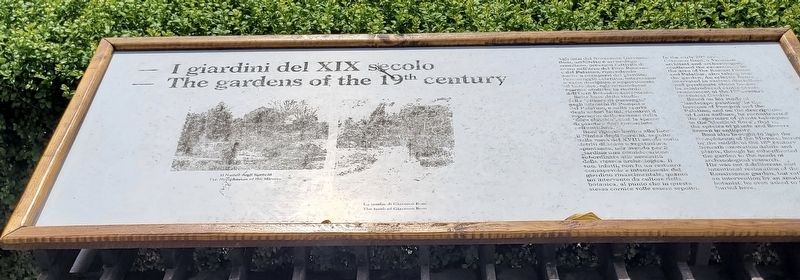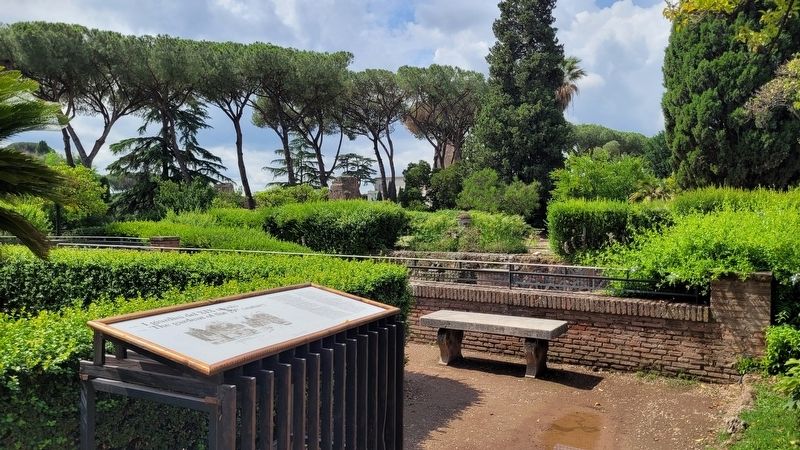Rione X Campitelli in Roma in Città metropolitana di Roma Capitale, Latium, Rome, Italy — Central Italy (Tyrrhenian Coast)
I giardini del XIX secolo / The gardens of the 19th century
Inscription.
Boni riporto inoltre alla luce il Ninfeo degli Specchi, sepulto dalla metà del XVIII setllolo sotto detriti di scavo e vegetazione spontanea, pur avendo per il giardino una considerazione subordinata alle necessità della ricerca archeologica. Il suo, infatti, non fu un restauro consapevole e intenzionale del giardino rinascimentale, quanto un intervento da cultore della botanica, al punto che in questa stessa cornice volle essere sepolto.
Didascalie
Il Ninfeo degli Specchi
La tomba di Giacomo Boni
In the early 20th century Giacomo Boni, a Venetian architect and archaeologist, continued the excavations in the area of the Roman Forum and Palatine, also taking over the garden. An eclectic figure, interested in various disciplines and passionate about botany, he reintroduced exotic plants reminiscent of the 17th century Botanical Garden.
Based on his study of "landscape painting" in the frescoes of Pompeii and the Palatine, and on the descriptions of Latin authors, he reconstructed the repertoire of plants belonging to the clustical flora, that is, the species of plants and flowers known in antiquity.
Boni also brought to light the Nymphaeum of the Mirrors, buried by the middle of the 18th century beneath excavation debris and plants, though he subordinated the garden to the needs of archacological research. His was not a deliberate and intentional restoration of the Renaissance garden, but rather an intervention by an amateur botanist; he even asked to be buried here.
Captions
The Nymphaeum of the Mirrors
The tomb of Giacomo Boni
Topics. This historical marker is listed in this topic list: Anthropology & Archaeology.
Location. 41° 53.419′ N, 12° 29.223′ E. Marker is in Roma
, Lazio (Latium, Rome), in Città metropolitana di Roma Capitale. It is in Rione X Campitelli. Marker is at the intersection of Via Sacra and Via Nova on Via Sacra. The marker is located west of the Arch of Titus in the Roman Forum. Touch for map. Marker is in this post office area: Roma, Lazio 00186, Italy. Touch for directions.
Other nearby markers. At least 8 other markers are within walking distance of this marker. Giacomo Boni sul Palatino / Giacomo Boni on the Palatine (here, next to this marker); Le Rose del Viridarium / The Roses of the Viridarium (a few steps from this marker); Le ragioni dell'archeologia / The development of archaeology (a few steps from this marker); I colori dell'abitare / The colours of dwelling (a few steps from this marker); Dal collezionismo all'archeologia / From collecting to archaeology (a few steps from this marker); Le case aristocratiche del Palatino / The Aristocratic Houses of the Palatine Hill (a few steps from this marker); Palatino: Il Giardino dei Farnese / The Palatin Hills: the Farnese Garden (a few steps from this marker); Uccelliere / Aviary (a few steps from this marker). Touch for a list and map of all markers in Roma.
More about this marker. The marker is located in the Parco Archeologico del Colosseo (Roman Forum Archaeological Park) and it does require an entry fee to visit.
Also see . . .
1. Parco Archeologico del Colosseo. Roma Turismo (Submitted on August 5, 2023, by James Hulse of Medina, Texas.)
2. Giacomo Boni (archaeologist). Wikipedia (Submitted on August 6, 2023, by James Hulse of Medina, Texas.)
Credits. This page was last revised on August 6, 2023. It was originally submitted on August 5, 2023, by James Hulse of Medina, Texas. This page has been viewed 41 times since then and 8 times this year. Photos: 1, 2. submitted on August 6, 2023, by James Hulse of Medina, Texas.

